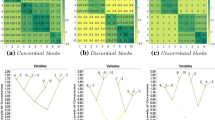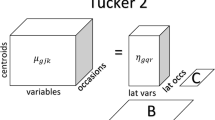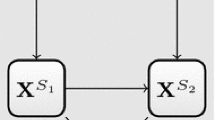Abstract
We introduce a dimension reduction method for visualizing the clustering structure obtained from a finite mixture of Gaussian densities. Information on the dimension reduction subspace is obtained from the variation on group means and, depending on the estimated mixture model, on the variation on group covariances. The proposed method aims at reducing the dimensionality by identifying a set of linear combinations, ordered by importance as quantified by the associated eigenvalues, of the original features which capture most of the cluster structure contained in the data. Observations may then be projected onto such a reduced subspace, thus providing summary plots which help to visualize the clustering structure. These plots can be particularly appealing in the case of high-dimensional data and noisy structure. The new constructed variables capture most of the clustering information available in the data, and they can be further reduced to improve clustering performance. We illustrate the approach on both simulated and real data sets.
Similar content being viewed by others
References
Banfield, J., Raftery, A.E.: Model-based Gaussian and non-Gaussian clustering. Biometrics 49, 803–821 (1993)
Bernard-Michel, C., Girard, S.: Gaussian regularized sliced inverse regression. Stat. Comput. 19(1), 85–98 (2009)
Biernacki, C., Celeux, G., Govaert, G.: Assessing a mixture model for clustering with the integrated completed likelihood. IEEE Trans. Pattern Anal. 22(7), 719–725 (2000)
Bishop, C.M., Tipping, M.E.: A hierarchical latent variable model for data visualization. IEEE Trans. Pattern Anal. 20(3), 281–293 (1998)
Bouveyron, C., Girard, S., Schmid, C.: High-dimensional data clustering. Comput. Stat. Data Anal. 52, 502–519 (2007)
Campbell, N., Mahon, R.: A multivariate study of variation in two species of rock crab of genus leptograpsus. Aust. J. Zool. 22, 417–425 (1974)
Celeux, G., Govaert, G.: Gaussian parsimonious clustering models. Pattern Recognit. 28, 781–793 (1995)
Celeux, G., Soromenho, G.: An entropy criterion for assessing the number of clusters in a mixture model. J. Classif. 2, 195–212 (1996)
Chang, W.: On using principal components before separating a mixture of two multivariate normal distributions. J. R. Stat. Soc. C Appl. Stat. 32(3) (1983)
Cook, R.D.: Regression Graphics: Ideas for Studying Regressions Through Graphics. Wiley, New York (1998)
Cook, R.D., Yin, X.: Dimension reduction and visualization in discriminant analysis (with discussion). Aust. NZ J. Stat. 43, 147–199 (2001)
Dempster, A.P., Laird, N.M., Rubin, D.B.: Maximum likelihood from incomplete data via the em algorithm (with discussion). J. R. Stat. Soc. B Methodol. 39, 1–38 (1977)
Forina, M., Armanino, C., Castino, M., Ubigli, M.: Multivariate data analysis as a discriminating method of the origin of wines. Vitis 25, 189–201 (1986). ftp://ftp.ics.uci.edu/pub/machine-learning-databases/wine. Wine Recognition Database
Fraley, C., Raftery, A.E.: How many clusters? Which clustering method? Answers via model-based cluster analysis. Comput. J. 41, 578–588 (1998)
Fraley, C., Raftery, A.E.: Model-based clustering, discriminant analysis, and density estimation. J. Am. Stat. Assoc. 97(458), 611–631 (2002)
Fraley, C., Raftery, A.E.: MCLUST version 3 for R: Normal mixture modeling and model-based clustering. Tech. Rep. 504, Department of Statistics, University of Washington (2006)
Ghosh, D., Chinnaiyan, A.M.: Mixture modelling of gene expression data from microarray experiments. Bioinformatics 18(2), 275–286 (2002)
Hubert, L., Arabie, P.: Comparing partitions. J. Classif. 2, 193–218 (1985)
Jolliffe, I.T.: Principal Component Analysis. Springer, New York (2002)
Kass, R.E., Raftery, A.E.: Bayes factors. J. Am. Stat. Assoc. 90, 773–795 (1995)
Li, K.C.: Sliced inverse regression for dimension reduction (with discussion). J. Am. Stat. Assoc. 86, 316–342 (1991)
Li, K.C.: High dimensional data analysis via the SIR/PHD approach. Unpublished manuscript (2000)
Maugis, C., Celeux, G., Martin-Magniette, M.-L.: Variable selection for clustering with Gaussian mixture models. Biometrics (2009, to appear)
McLachlan, G., Peel, D.: Finite Mixture Models. Wiley, New York (2000)
McLachlan, G., Peel, D., Bean, R.: Modelling high-dimensional data by mixtures of factor analyzers. Comput. Stat. Data Anal. 41, 379–388 (2003)
McNicholas, P., Murphy, T.: Parsimonious Gaussian mixture models. Stat. Comput. 18, 285–296 (2008)
Raftery, A.E., Dean, N.: Variable selection for model-based clustering. J. Am. Stat. Assoc. 101(473), 168–178 (2006)
Schwartz, G.: Estimating the dimension of a model. Ann. Stat. 6, 31–38 (1978)
Tipping, M.E., Bishop, C.M.: Mixtures of probabilistic principal component analyzers. Neural Comput. 11(2), 443–482 (1999a)
Tipping, M.E., Bishop, C.M.: Probabilistic principal component analysis. J. R. Stat. Soc. B Methodol. 61, 611–622 (1999b)
Yeung, K.Y., Fraley, C., Murua, A., Raftery, A.E., Ruzzo, W.L.: Model-based clustering and data transformations for gene expression data. Bioinformatics 17(10), 977–987 (2001)
Author information
Authors and Affiliations
Corresponding author
Rights and permissions
About this article
Cite this article
Scrucca, L. Dimension reduction for model-based clustering. Stat Comput 20, 471–484 (2010). https://doi.org/10.1007/s11222-009-9138-7
Received:
Accepted:
Published:
Issue Date:
DOI: https://doi.org/10.1007/s11222-009-9138-7




